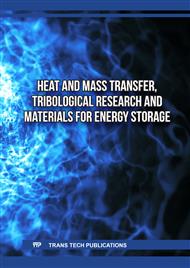[1]
Ohalete, N., Aderibigbe, A., Ani, E., Ohenhen, P., & Daraojimba, D. (2024). Challenges and innovations in electro-mechanical system integration: a review. Acta Electronica Malaysia (AEM).
Google Scholar
[2]
Reveles-Miranda, M., Ramirez-Rivera, V., & Pacheco-Catalán, D. (2024). Hybrid energy storage: Features, applications, and ancillary benefits. Renewable and Sustainable Energy Reviews, 192, 114196.
DOI: 10.1016/j.rser.2023.114196
Google Scholar
[3]
Jasrotia, P., & Kumar, T. (2024). Eco-Friendly Supercapacitors: Key Elements in a Sustainable Energy Landscape. In Eco-Friendly Supercapacitors: Design and Future Perspectives in Sustainable and Green Energy Storage Devices (pp.139-162). American Chemical Society.
DOI: 10.1021/bk-2024-1471.ch006
Google Scholar
[4]
Phor, L., Kumar, A., & Chahal, S. (2024). Electrode materials for supercapacitors: a comprehensive review of advancements and performance. Journal of Energy Storage, 84, 110698.
DOI: 10.1016/j.est.2024.110698
Google Scholar
[5]
Urade, A. R., Lahiri, I., & Suresh, K. S. (2023). Graphene properties, synthesis and applications: a review. Jom, 75(3), 614-630.
DOI: 10.1007/s11837-022-05505-8
Google Scholar
[6]
Lin, J., Peng, Z., Liu, Y., Ruiz-Zepeda, F., Ye, R., Samuel, E. L., ... & Tour, J. M. (2014). Laser-induced porous graphene films from commercial polymers. Nature communications, 5(1), 5714.
DOI: 10.1038/ncomms6714
Google Scholar
[7]
Mohamed, S. R., Abdul-Aziz, M. R., Saber, S., Khabiri, G., & Khalil, A. S. (2023). Precise engineering of Fe3O4/MWCNTs heterostructures for high-performance supercapacitors. Journal of Alloys and Compounds, 957, 170281.
DOI: 10.1016/j.jallcom.2023.170281
Google Scholar
[8]
Sharma, R., Kumar, H., Kumar, G., Sharma, S., Aneja, R., Sharma, A. K., ... & Kumar, P. (2023). Progress and challenges in electrochemical energy storage devices: Fabrication, electrode material, and economic aspects. Chemical Engineering Journal, 468, 143706.
DOI: 10.1016/j.cej.2023.143706
Google Scholar
[9]
Muzaffar, A., Ahamed, M. B., & Hussain, C. M. (2023). Electrolyte materials for supercapacitors. In Smart Supercapacitors (pp.227-254). Elsevier.
DOI: 10.1016/b978-0-323-90530-5.00031-9
Google Scholar
[10]
Sindhu, B., Kothuru, A., Sahatiya, P., Goel, S., & Nandi, S. (2021). Laser-induced graphene printed wearable flexible antenna-based strain sensor for wireless human motion monitoring. IEEE Transactions on Electron Devices, 68(7), 3189-3194.
DOI: 10.1109/ted.2021.3067304
Google Scholar
[11]
Ott, A. K., & Ferrari, A. C. (2024). Raman spectroscopy of graphene and related materials. Encyclopedia of Condensed Matter Physics, 2nd ed.; Chakraborty, T., Ed, 233-247.
DOI: 10.1016/b978-0-323-90800-9.00252-3
Google Scholar
[12]
Dixit, N., & Singh, S. P. (2022). Laser-induced graphene (LIG) as a smart and sustainable material to restrain pandemics and endemics: A perspective. ACS omega, 7(6), 5112-5130.
DOI: 10.1021/acsomega.1c06093
Google Scholar
[13]
Karimi, Z., Moon, J., Malzahn, J., Eddings, E., & Warren, R. (2023). Ultra-low cost supercapacitors from coal char: effect of electrolyte on double layer capacitance. Energy Advances, 2(7), 1036-1044.
DOI: 10.1039/d3ya00064h
Google Scholar
[14]
Chowdhury, A., Dhar, A., Biswas, S., Sharma, V., Burada, P. S., & Chandra, A. (2020). Theoretical model for magnetic supercapacitors—From the electrode material to electrolyte ion dependence. The Journal of Physical Chemistry C, 124(49), 26613-26624.
DOI: 10.1021/acs.jpcc.0c07538
Google Scholar
[15]
Zhong, C., Deng, Y., Hu, W., Qiao, J., Zhang, L., & Zhang, J. (2015). A review of electrolyte materials and compositions for electrochemical supercapacitors. Chemical Society Reviews, 44(21), 7484-7539.
DOI: 10.1039/c5cs00303b
Google Scholar
[16]
Makinde, W. O., Hassan, M. A., Pan, Y., Guan, G., López-Salas, N., & Khalil, A. S. (2024). Sulfur and nitrogen co-doping of peanut shell-derived biochar for sustainable supercapacitor applications. Journal of Alloys and Compounds, 991, 174452.
DOI: 10.1016/j.jallcom.2024.174452
Google Scholar
[17]
Abdul-Aziz, M. R., Hassan, A., Abdel-Aty, A. A., Saber, M. R., Ghannam, R., Anis, B., ... & Khalil, A. S. (2020). High performance supercapacitor based on laser induced graphene for wearable devices. IEEE Access, 8, 200573-200580.
DOI: 10.1109/access.2020.3035828
Google Scholar


